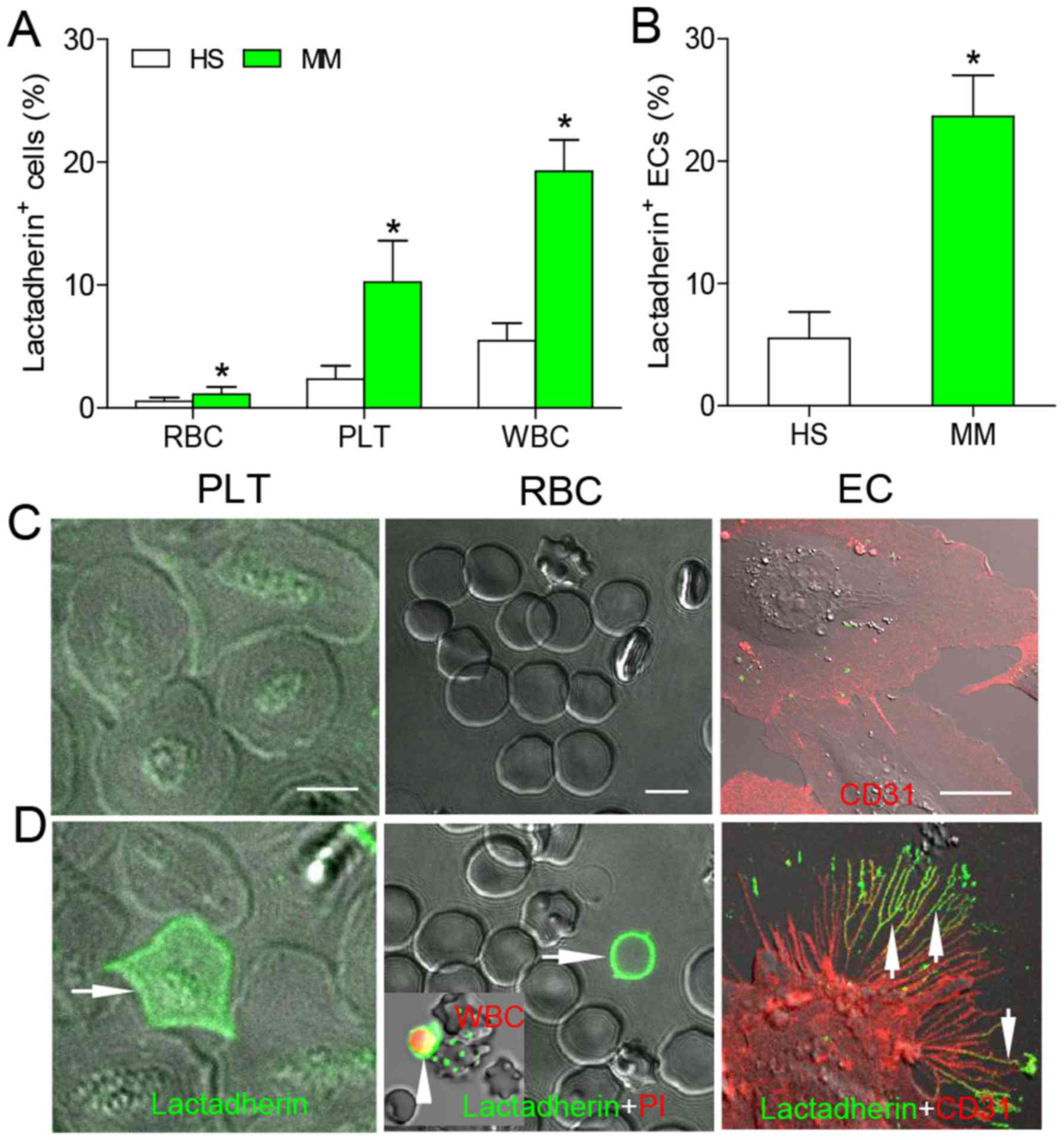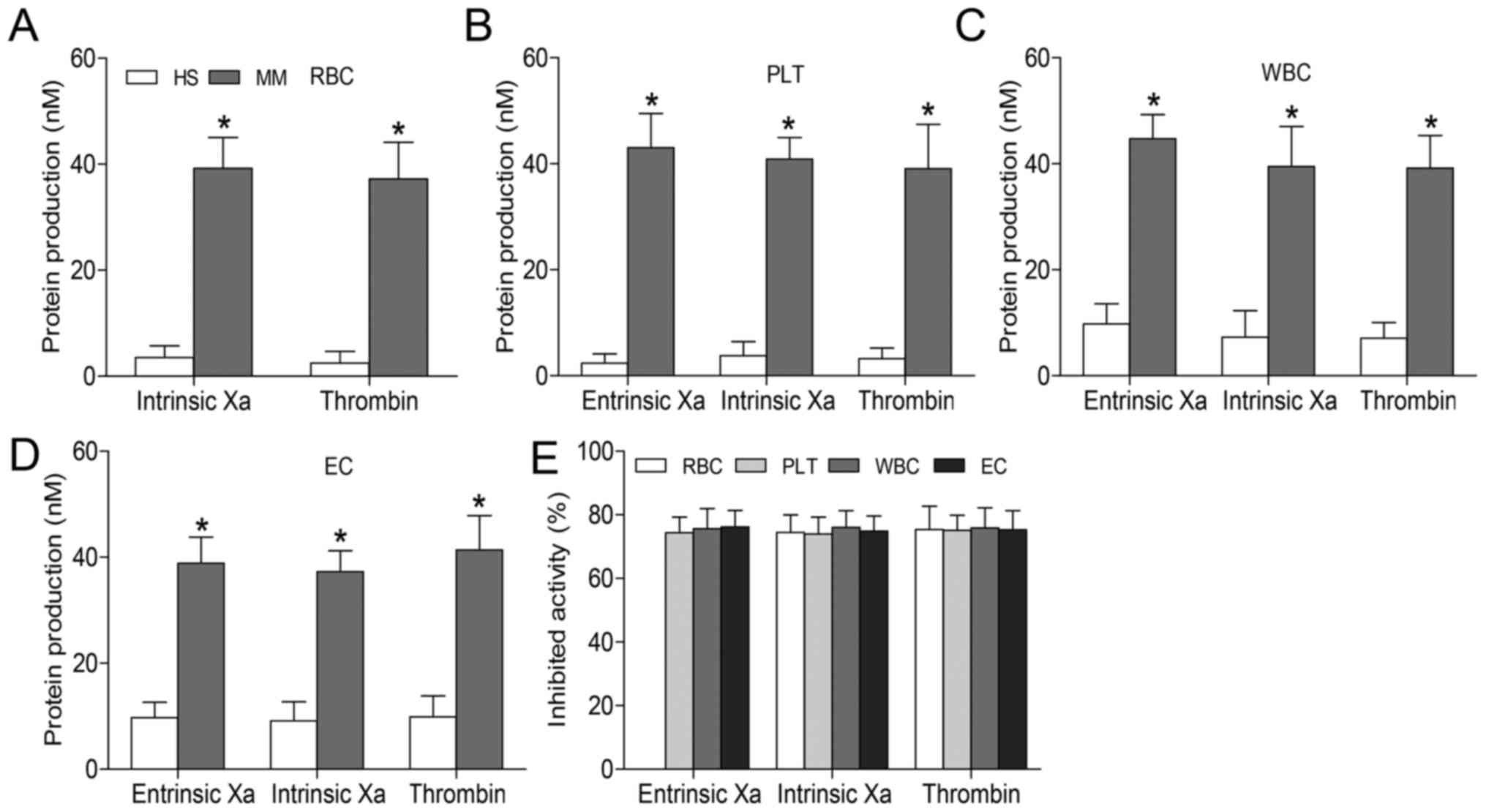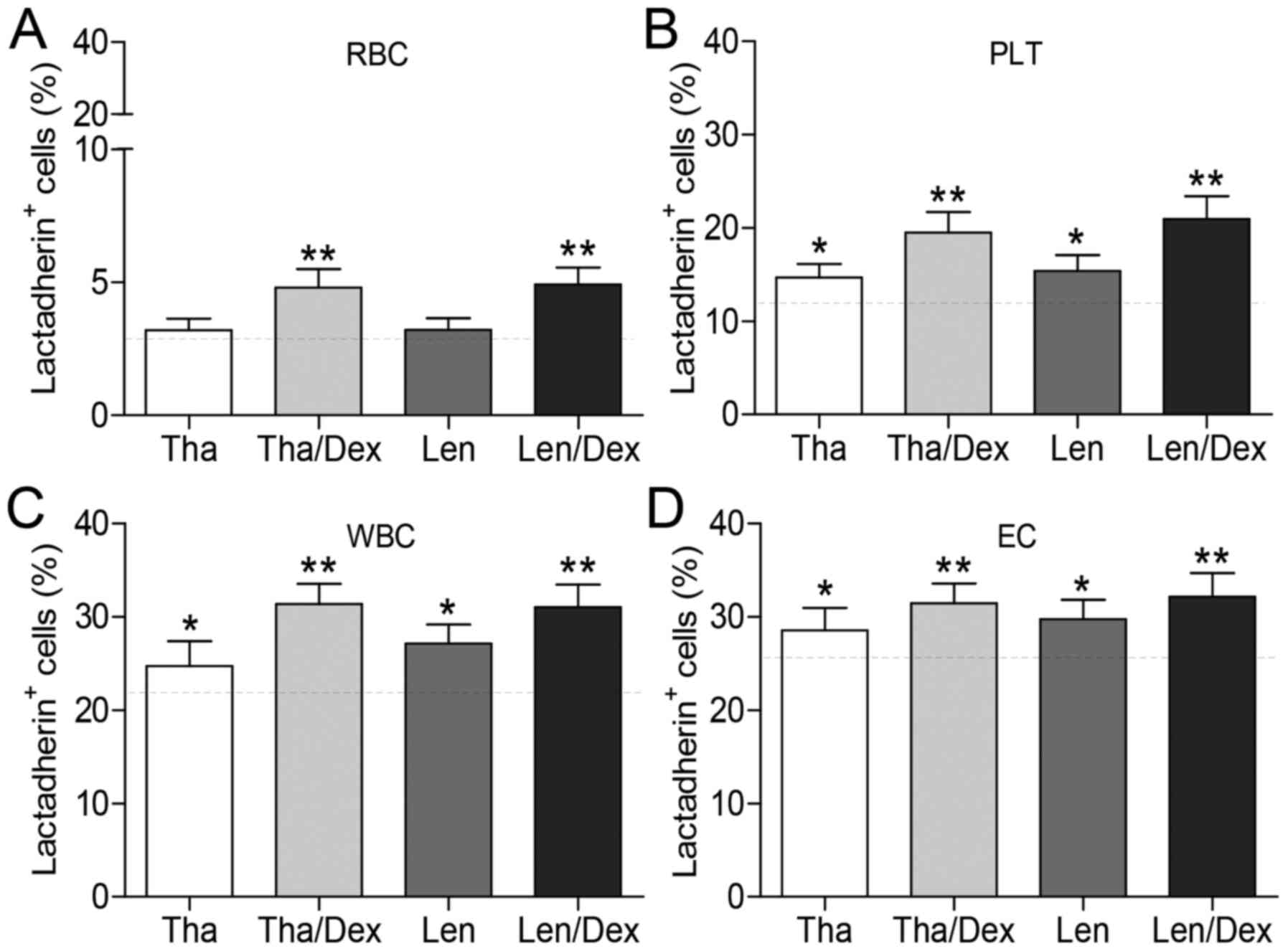|
1
|
Kristinsson SY, Pfeiffer RM, Björkholm M,
Goldin LR, Schulman S, Blimark C, Mellqvist UH, Wahlin A, Turesson
I and Landgren O: Arterial and venous thrombosis in monoclonal
gammopathy of undetermined significance and multiple myeloma: A
population-based study. Blood. 115:4991–4998. 2010. View Article : Google Scholar
|
|
2
|
Blom JW, Doggen CJ, Osanto S and Rosendaal
FR: Malignancies, prothrombotic mutations, and the risk of venous
thrombosis. JAMA. 293:715–722. 2005. View Article : Google Scholar
|
|
3
|
Kristinsson SY, Pfeiffer RM, Björkholm M,
Schulman S and Landgren O: Thrombosis is associated with inferior
survival in multiple myeloma. Haematologica. 97:1603–1607. 2012.
View Article : Google Scholar
|
|
4
|
Palumbo A, Rajkumar SV, Dimopoulos MA,
Richardson PG, San Miguel J, Barlogie B, Harousseau J, Zonder JA,
Cavo M, Zangari M, et al International Myeloma Working Group:
Prevention of thalidomide- and lenalidomide-associated thrombosis
in myeloma. Leukemia. 22:414–423. 2008. View Article : Google Scholar
|
|
5
|
De Stefano V, Za T and Rossi E: Venous
thromboembolism in multiple myeloma. Semin Thromb Hemost.
40:338–347. 2014. View Article : Google Scholar
|
|
6
|
Auwerda JJ, Sonneveld P, de Maat MP and
Leebeek FW: Prothrombotic coagulation abnormalities in patients
with newly diagnosed multiple myeloma. Haematologica. 92:279–280.
2007. View Article : Google Scholar
|
|
7
|
Minnema MC, Fijnheer R, De Groot PG and
Lokhorst HM: Extremely high levels of von Willebrand factor antigen
and of procoagulant factor VIII found in multiple myeloma patients
are associated with activity status but not with thalidomide
treatment. J Thromb Haemost. 1:445–449. 2003. View Article : Google Scholar
|
|
8
|
Elice F, Fink L, Tricot G, Barlogie B and
Zangari M: Acquired resistance to activated protein C (aAPCR) in
multiple myeloma is a transitory abnormality associated with an
increased risk of venous thromboembolism. Br J Haematol.
134:399–405. 2006. View Article : Google Scholar
|
|
9
|
van Marion AM, Auwerda JJ, Minnema MC, van
Oosterom R, Adelmeijer J, de Groot PG, Leebeek FW, Sonneveld P,
Lokhorst HM and Lisman T: Hypofibrinolysis during induction
treatment of multiple myeloma may increase the risk of venous
thrombosis. Thromb Haemost. 94:1341–1343. 2005.
|
|
10
|
Zwaal RF and Schroit AJ: Pathophysiologic
implications of membrane phospholipid asymmetry in blood cells.
Blood. 89:1121–1132. 1997.
|
|
11
|
Vance JE and Steenbergen R: Metabolism and
functions of phosphatidylserine. Prog Lipid Res. 44:207–234. 2005.
View Article : Google Scholar
|
|
12
|
Gao C, Xie R, Yu C, Wang Q, Shi F, Yao C,
Xie R, Zhou J, Gilbert GE and Shi J: Procoagulant activity of
erythrocytes and platelets through phosphatidylserine exposure and
microparticles release in patients with nephrotic syndrome. Thromb
Haemost. 107:681–689. 2012. View Article : Google Scholar
|
|
13
|
Zhou J, Shi J, Hou J, Cao F, Zhang Y,
Rasmussen JT, Heegaard CW and Gilbert GE: Phosphatidylserine
exposure and procoagulant activity in acute promyelocytic leukemia.
J Thromb Haemost. 8:773–782. 2010. View Article : Google Scholar
|
|
14
|
Jurczyszyn A, Czepiel J, Biesiada G,
Gdula-Argasińska J, Cibor D, Owczarek D, Perucki W and Skotnicki
AB: HGF, sIL-6R and TGF-β1 play a significant role in the
progression of multiple myeloma. J Cancer. 5:518–524. 2014.
View Article : Google Scholar
|
|
15
|
Fritz E, Ludwig H, Scheithauer W and
Sinzinger H: Shortened platelet half-life in multiple myeloma.
Blood. 68:514–520. 1986.
|
|
16
|
Lee H, Kong SY, Sohn JY, Shim H, Youn HS,
Lee S, Kim HJ and Eom HS: Elevated red blood cell distribution
width as a simple prognostic factor in patients with symptomatic
multiple myeloma. Biomed Res Int. 2014:1456192014.
|
|
17
|
Kerr R, Stirling D and Ludlam CA:
Interleukin 6 and haemostasis. Br J Haematol. 115:3–12. 2001.
View Article : Google Scholar
|
|
18
|
Mechtcheriakova D, Schabbauer G, Lucerna
M, Clauss M and De Martin R, Binder BR, Hofer E and De Martin R:
Specificity, diversity, and convergence in VEGF and TNF-alpha
signaling events leading to tissue factor up-regulation via EGR-1
in endothelial cells. FASEB J. 15:230–242. 2001. View Article : Google Scholar
|
|
19
|
Hoshi A, Matsumoto A, Chung J, Isozumi Y
and Koyama T: Activation of coagulation by a thalidomide-based
regimen. Blood Coagul Fibrinolysis. 22:532–540. 2011. View Article : Google Scholar
|
|
20
|
Isozumi Y, Arai R, Fujimoto K and Koyama
T: Activation of coagulation by lenalidomide-based regimens for the
treatment of multiple myeloma. PLoS One. 8:e643692013. View Article : Google Scholar
|
|
21
|
Shi J, Shi Y, Waehrens LN, Rasmussen JT,
Heegaard CW and Gilbert GE: Lactadherin detects early
phosphatidylserine exposure on immortalized leukemia cells
undergoing programmed cell death. Cytometry A. 69:1193–1201. 2006.
View Article : Google Scholar
|
|
22
|
Rajkumar SV, Dimopoulos MA, Palumbo A,
Blade J, Merlini G, Mateos MV, Kumar S, Hillengass J, Kastritis E,
Richardson P, et al: International Myeloma Working Group updated
criteria for the diagnosis of multiple myeloma. Lancet Oncol.
15:e538–e548. 2014. View Article : Google Scholar
|
|
23
|
Lang E, Gatidis S, Freise NF, Bock H,
Kubitz R, Lauermann C, Orth HM, Klindt C, Schuier M, Keitel V, et
al: Conjugated bilirubin triggers anemia by inducing erythrocyte
death. Hepatology. 61:275–284. 2015. View Article : Google Scholar
|
|
24
|
NaveenKumar SK, Thushara RM, Sundaram MS,
Hemshekhar M, Paul M, Thirunavukkarasu C, Basappa, Nagaraju G,
Raghavan SC, Girish KS, et al: Unconjugated bilirubin exerts
pro-apoptotic effect on platelets via p38-MAPK activation. Sci Rep.
5:150452015. View Article : Google Scholar
|
|
25
|
Khan NM and Poduval TB: Immunomodulatory
and immu-notoxic effects of bilirubin: Molecular mechanisms. J
Leukoc Biol. 90:997–1015. 2011. View Article : Google Scholar
|
|
26
|
Campbell RA, Overmyer KA, Selzman CH,
Sheridan BC and Wolberg AS: Contributions of extravascular and
intravascular cells to fibrin network formation, structure, and
stability. Blood. 114:4886–4896. 2009. View Article : Google Scholar
|
|
27
|
Eby C: Pathogenesis and management of
bleeding and thrombosis in plasma cell dyscrasias. Br J Haematol.
145:151–163. 2009. View Article : Google Scholar
|
|
28
|
Koupenova M, Kehrel BE, Corkrey HA and
Freedman JE: Thrombosis and platelets: An update. Eur Heart J.
38:785–791. 2017.
|
|
29
|
Swystun LL and Liaw PC: The role of
leukocytes in thrombosis. Blood. 128:753–762. 2016. View Article : Google Scholar
|
|
30
|
Bonomini M, Sirolli V, Gizzi F, Di Stante
S, Grilli A and Felaco M: Enhanced adherence of human uremic
erythrocytes to vascular endothelium: Role of phosphatidylserine
exposure. Kidney Int. 62:1358–1363. 2002. View Article : Google Scholar
|
|
31
|
Solá E, Vayá A, Martínez M, Moscardó A,
Corella D, Santaolaria ML, España F and Hernández-Mijares A:
Erythrocyte membrane phosphatidylserine exposure in obesity.
Obesity (Silver Spring). 17:318–322. 2009. View Article : Google Scholar
|
|
32
|
Aird WC: Phenotypic heterogeneity of the
endothelium: II. Representative vascular beds. Circ Res.
100:174–190. 2007. View Article : Google Scholar
|
|
33
|
Levi M, Nieuwdorp M, van der Poll T and
Stroes E: Metabolic modulation of inflammation-induced activation
of coagulation. Semin Thromb Hemost. 34:26–32. 2008. View Article : Google Scholar
|
|
34
|
Petropoulou AD, Gerotziafas GT, Samama MM,
Hatmi M, Rendu F and Elalamy I: In vitro study of the
hypercoagulable state in multiple myeloma patients treated or not
with thalidomide. Thromb Res. 121:493–497. 2008. View Article : Google Scholar
|
|
35
|
Cimmino G, Ciccarelli G and Golino P: Role
of tissue factor in the coagulation network. Semin Thromb Hemost.
41:708–717. 2015. View Article : Google Scholar
|
|
36
|
Chen VM and Hogg PJ: Encryption and
decryption of tissue factor. J Thromb Haemost. 11(Suppl 1):
277–284. 2013. View Article : Google Scholar
|
|
37
|
Dunkley S and Gaudry L: Thalidomide causes
platelet activation, which can be abrogated by aspirin. J Thromb
Haemost. 5:1323–1325. 2007. View Article : Google Scholar
|
|
38
|
Rosovsky R, Hong F, Tocco D, Connell B,
Mitsiades C, Schlossman R, Ghobrial I, Lockridge L, Warren D,
Bradwin G, et al: Endothelial stress products and coagulation
markers in patients with multiple myeloma treated with lenalidomide
plus dexamethasone: An observational study. Br J Haematol.
160:351–358. 2013. View Article : Google Scholar
|
|
39
|
Quach H, Ritchie D, Stewart AK, Neeson P,
Harrison S, Smyth MJ and Prince HM: Mechanism of action of
immunomodulatory drugs (IMiDS) in multiple myeloma. Leukemia.
24:22–32. 2010. View Article : Google Scholar
|
|
40
|
Wang J, Guo H and Zhou X: Clinical utility
and patient consideration in the use of lenalidomide for multiple
myeloma in Chinese patients. Onco Targets Ther. 8:1277–1284.
2015.
|




















